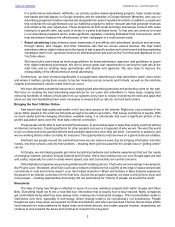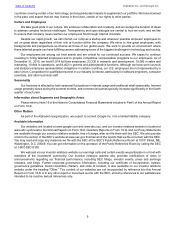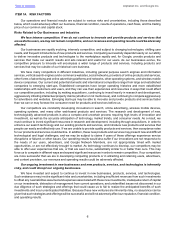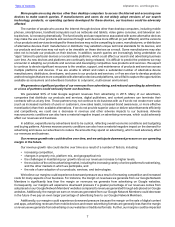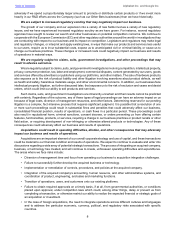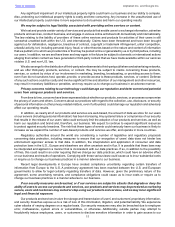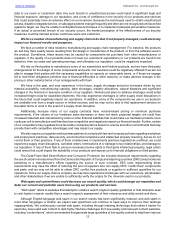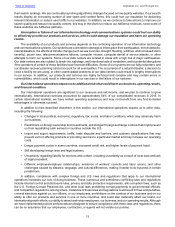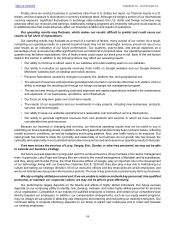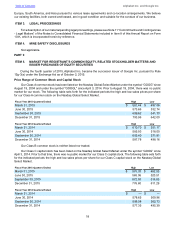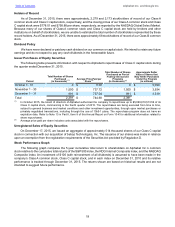Google 2015 Annual Report Download - page 16
Download and view the complete annual report
Please find page 16 of the 2015 Google annual report below. You can navigate through the pages in the report by either clicking on the pages listed below, or by using the keyword search tool below to find specific information within the annual report.
Table of Contents Alphabet Inc. and Google Inc.
12
data or our users’ or customers’ data. Any such breach or unauthorized access could result in significant legal and
financial exposure, damage to our reputation, and a loss of confidence in the security of our products and services
that could potentially have an adverse effect on our business. Because the techniques used to obtain unauthorized
access, disable or degrade service, or sabotage systems change frequently and often are not recognized until launched
against a target, we may be unable to anticipate these techniques or to implement adequate preventative measures.
If an actual or perceived breach of our security occurs, the market perception of the effectiveness of our security
measures could be harmed and we could lose users and customers.
We face a number of manufacturing and supply chain risks that, if not properly managed, could adversely
impact our financial results and prospects.
We face a number of risks related to manufacturing and supply chain management. For instance, the products
we sell may have quality issues resulting from the design or manufacture of the product, or from the software used in
the product. Sometimes, these issues may be caused by components we purchase from other manufacturers or
suppliers. If the quality of our products does not meet our customers' expectations or our products are found to be
defective, then our sales and operating earnings, and ultimately our reputation, could be negatively impacted.
We rely on third parties to manufacture many of our assemblies and finished products, and we have third-party
arrangements for the design of some components and parts. Our business could be negatively affected if we are not
able to engage third parties with the necessary capabilities or capacity on reasonable terms, or if those we engage
fail to meet their obligations (whether due to financial difficulties or other reasons), or make adverse changes in the
pricing or other material terms of our arrangements with them.
We have in the past, and may experience in the future, supply shortages and price increases driven by raw
material availability, manufacturing capacity, labor shortages, industry allocations, natural disasters and significant
changes in the financial or business condition of our suppliers. Workaround plans to address shortages could entail
increased freight costs for expedited shipments. We may experience shortages or other supply chain disruptions in
the future that could negatively impact our operations. In addition, some of the components we use in our products
are available only from a single source or limited sources, and we may not be able to find replacement vendors on
favorable terms or at all in the event of a supply chain disruption.
Additionally, because many of our supply contracts have volume-based pricing or minimum purchase
requirements, if the volume of our hardware sales decreases or does not reach projected targets, we could face
increased materials and manufacturing costs or other financial liabilities that could make our hardware products more
costly per unit to manufacture and therefore less competitive and negatively impact our financial results. Further, certain
of our competitors may negotiate more favorable contractual terms based on volume and other commitments that may
provide them with competitive advantages and may impact our supply.
We also require our suppliers and business partners to comply with law and company policies regarding workplace
and employment practices, data security, environmental compliance and intellectual property licensing, but we do not
control them or their practices. If any of them violates laws or implements practices regarded as unethical, we could
experience supply chain disruptions, canceled orders, terminations of or damage to key relationships, and damage to
our reputation. If any of them fails to procure necessary license rights to third-party intellectual property, legal action
could ensue that could impact the saleability of our products and expose us to financial obligations to third parties.
The Dodd-Frank Wall Street Reform and Consumer Protection Act includes disclosure requirements regarding
the use of certain minerals mined from the Democratic Republic of Congo and adjoining countries (DRC) and procedures
pertaining to a manufacturer's efforts regarding the source of such minerals. SEC rules implementing these
requirements may have the effect of reducing the pool of suppliers who can supply DRC “conflict free” components
and parts, and we may not be able to obtain DRC conflict free products or supplies in sufficient quantities for our
operations. Since our supply chain is complex, we may face reputational challenges with our customers, stockholders
and other stakeholders if we are unable to sufficiently verify the origins for the minerals used in our products.
Web spam and content farms could decrease our search quality, which could damage our reputation and
deter our current and potential users from using our products and services.
“Web spam” refers to websites that attempt to violate a search engine's quality guidelines or that otherwise seek
to rank higher in search results than a search engine's assessment of their relevance and utility would rank them.
Although English-language web spam in our search results has been significantly reduced, and web spam in
most other languages is limited, we expect web spammers will continue to seek ways to improve their rankings
inappropriately. We continuously combat web spam, including through indexing technology that makes it harder for
spam-like, less useful web content to rank highly. We face challenges from low-quality and irrelevant content websites,
including “content farms”, which are websites that generate large quantities of low-quality content to help them improve



